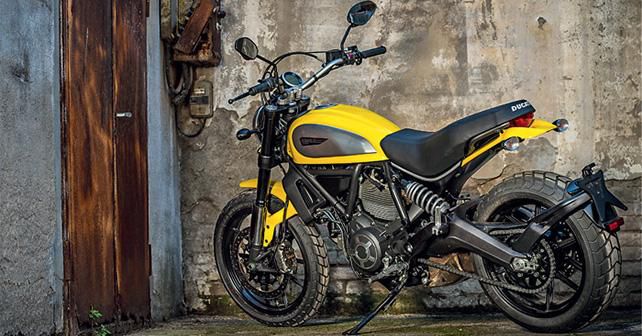
The heir to the legendary ‘rebel’ of the 1960’s and 70’s has arrived. The Scrambler is Ducati’s contemporary interpretation of an icon from yesteryear. Its post-heritage style signals a return to the pure essence of motorcycling that translates into a huge amount of fun. Most of all, it’s being built so you can express yourself.
It’s called the Scrambler Ducati, not Ducati Scrambler. A small detail? Not necessarily.
This interchange of the words might appear meaningless, but it could be very important. Perhaps it’s the first sign of a new marketing strategy, as has happened before with the old (and famous) Piaggio Vespa – which became simply ‘Vespa’ overnight. Perhaps it’s the first step towards the creation of a new brand. It is certainly a revolution in Borgo Panigale (Bologna’s quarter, central Italy, home of the Ducati brand), and seems perfect to represent whatever lies behind this new bike. The Scrambler is called ‘post-heritage,’ a concept which acknowledges the passing of a cultural heritage and a willingness to open up to the future.
And so, when the Ducati team in Bologna began to discuss resurrecting the Scrambler, the question it had to answer was – How would this bike be today, if the company had never stopped producing it in the ‘70’s? The answer is now in front of us. The Ducati team thought that it wouldn’t make sense to remake a vintage model, which replicated the famous single cylinder with its rebellious nature and its ‘little Yankees’ shape. No, it was definitely not the right solution. What has been borrowed from that piece of history on two wheels is the guiding philosophy – freedom and lightness to face life, seasoned with a dash of unconventionality and of breaking the mould. Ducati insists that it’s not a retro bike.
ICON
CLASSIC
Just break the rules a little bit – that was the line of thought the working group put together by project manager Mario Alvisi started with. But the situation immediately took an unexpected turn for a ‘marketing oriented’ company like Ducati. They started with a motorcycle that should have been an ordinary one, but ended up handling a larger-than-life dream. For starters, they created an unconventional workplace in Borgo Panigale. The ‘Scrambler’ office has green artificial grass on the floor and brown wooden walls, decorated with paintings and objects of vintage design that share space with recycled industrial goods.
Besides the layout and design, there were other ‘creative’ mechanisms that reflected a project that involved engineers, designers, and every other department that worked on the definition of this motorbike. It was a sort of collective brainstorming where each view was minutely analysed. Many of those views came in the form of messages on hundreds of post-it notes left outside the office by the company’s curious employees.
URBAN ENDURO
FULL THROTTLE
The Scrambler’s communication also followed an unconventional route. For instance, Ducati organised an exhibition at the business square of its headquarters for a preview of the motorbike for all its employees. Who would have expected that at the World Ducati Week, Ducati lovers would get to see the preview even before the motoring press? And who knew that the Scrambler dream was shared and created in an incisive way by a creative filmmaker? The Scrambler is a new world. It’s not just the name of a new motorcycle made ??by Ducati. The Scrambler is an entity in itself. A trademark!
EVOLUTION OF THE SPECIES
The Scrambler is a modern product that draws inspiration from tradition only for its philosophy, nothing more. The 2015 edition comes in four models – Icon, Urban Enduro, Full Throtle, and Classic. The Scrambler also aims to be a technical platform on which it’s possible to build one’s own special bike – drawing on from an extensive catalogue of accessories. If you want, you can mix the different options available to get a unique final result. However, there’s no doubt that some of the details are unmistakably linked to the legendary single-cylinder born in the 60’s – like the teardrop steel tank in brushed aluminium, or the curved seat, the bent, wide handlebars, and the fuel tank cap.
Other than these items, everything else is new, which makes the Scrambler a modern product. The swing arm stands out for its curved shape, the beefy front forks are upside down, the mono rear shock absorber is offset to the left, and the wheel rims are light-aluminium alloy. The exhaust manifold follows the latest design from Ducati. The Scrambler is shod with an 18-inch tyre in the front, while the rear wheel is 17-inches. The rear light diffuser is a classy detail. The ignition switch harks back to the shape of the lights on the older Scrambler. Clearly, the designers have worked meticulously on the details of every component.
The frame, in line with Ducati’s tradition, is a trellis – and the twin-cylinder engine is L-shaped. The engine is simple and powerful, without showing any excess. Derived from the Monster 796, it’s been downsized with a single 50mm throttle body and two injectors to optimise power delivery at low and medium engine speeds. The camshaft placed at 11-degrees was designed for the angle of rotation of the crankshaft during which the intake and exhaust valves remain open simultaneously to mellow the engine’s response.

Scrambler Ducati:- • 803cc • 2-cylinders • Air-cooled • 74bhp • 68Nm
The new Scrambler, with it circular LED lights, is strangely reminiscent of a familiar sight from the ‘60’s – regular motorcycle headlights with an ‘X’ taped on top to avoid scattering pieces of glass in the event of a crash. Above, a sketch of the motorbike designed by the young Julien Clement. Four different versions are available – Icon, Classic, Urban Enduro and Full Throttle
The full-bodied saddle hides the passenger grab rails. The swing arm has enough space for the catalytic converter and the exhaust. Below are a few glimpses of the work space in which the Scrambler was designed
MARIO ALVISI: BACK TO THE ESSENCE
One foot on synthetic grass, the other on a skate. We are in his “Land of Joy,” his office. And Mario Alvisi, Scrambler Brand Director, tells us that to create this motorbike they didn’t start with the usual market research that’s normally used to find and target a certain type of customer. “We worked, first of all, on values, our personal values – the values that we felt were our own cultural ones, not linked to a marketing exercise. A casual approach to life, avoiding stereotypes, and freely expressing ourselves! The goal is to return to something essential, but not using too many contemporary and technological features. Do we want the simple pleasure of having fun? Of course, we want it, and it’s already in Ducati’s history and blood... and that’s the Scrambler!”
In addition to the approach, the perspective also changed. “For this project, some things needed to be done ad hoc, and it had to be different from the Ducati spirit that we all know. It was necessary to create a brand in itself, and this was supported by Ducati. The freedom given to us by the company has been enormous, which is a great sign of trust,” says Alvisi. A new way of thinking was also evident in the presentation of the motorbike to all the employees, to the public, and to the press. For Mario Alvisi, formal communication no longer exists because formality doesn’t seem important anymore. And the Scrambler is the proof of all this.
CLAUDIO DE ANGELI
(Clothing and Accessories Manager)
“Let me tell you about the moustache. Franco was a Ducati test rider and Elvira was an employee. They were perfect for the Scrambler’s advertisement. His whiskers were unique, and that’s where we found the inspiration for our motto: ‘Follow the moustache.’ It creates a sense of curiosity and entertainment.”
ANTONIO ZANDI
(Vehicle Engineer)
“I’m too young to have fully lived the Scrambler myth... So we talked to a lot of people about the important characteristics of the bike. Using that, we started the design – but with an innovative mindset.”
FEDERICO SABBIONI
(Product Manager)
“For the first time in the history of Ducati, nobody asks about the number of cylinders, nobody asks about traction control, or if its suspension is adjustable... We’ve succeeded in escaping from the usual. We’re breaking the mould.”
ANDREA FERRARESI
(Director, Ducati Design Centre)
“When you show off the fragile prototype’s resin mock up, and people begin to touch every single detail – so much so that they break something – then you know you’ve done a good job. In the end, the Scrambler stayed together thanks to shovels of glue.”
SCRAMBLER DUCATI
ENGINE
2-cylinders, 803cc, air-cooled, compression ratio of 11.0:1, single overhead camshaft, 4 valves, electronic fuel injection with one 50mm throttle body, wet sump lubrication.
Final drive (46/15)
Transmission
Multi-plate clutch in oil bath, mechanically operated. 6-speed gearbox
Electronic controls to be managed by the rider: None
Chassis
Trellis frame of steel tubes, 24.0°steering head angle, 112mm trail; 41mm non-adjustable inverted front forks; aluminium swingarm and mono rear shock absorber with adjustable spring preload – 150/150 mm travel
Brakes
Front: 330mm disc, radial 4-piston caliper
Rear: 245mm disc, single-piston caliper; ABS as standard
Tyres
Front 110/80 R18
Rear 180/55 R17
Dimensions (mm)
2,100-2,165 length, 845 width, 1,445
wheelbase, 790 seat height, 13.5 litre fuel tank, dry weight of 170kgs
Stated performance
74bhp @ 8,250rpm
68Nm @ 5,750rpm
Available colours
4 versions: Icon (red and yellow), Urban Enduro, Full Throttle, and Classic
Below, swingarm and single adjustable preload, minimal instrumentation, and a single front disc of 330mm (ABS is the only concession to the electronic world). The tank is very well made – the cap, alloy wheels, and the seat are also excellent
© Riproduzione riservata







































Write your Comment